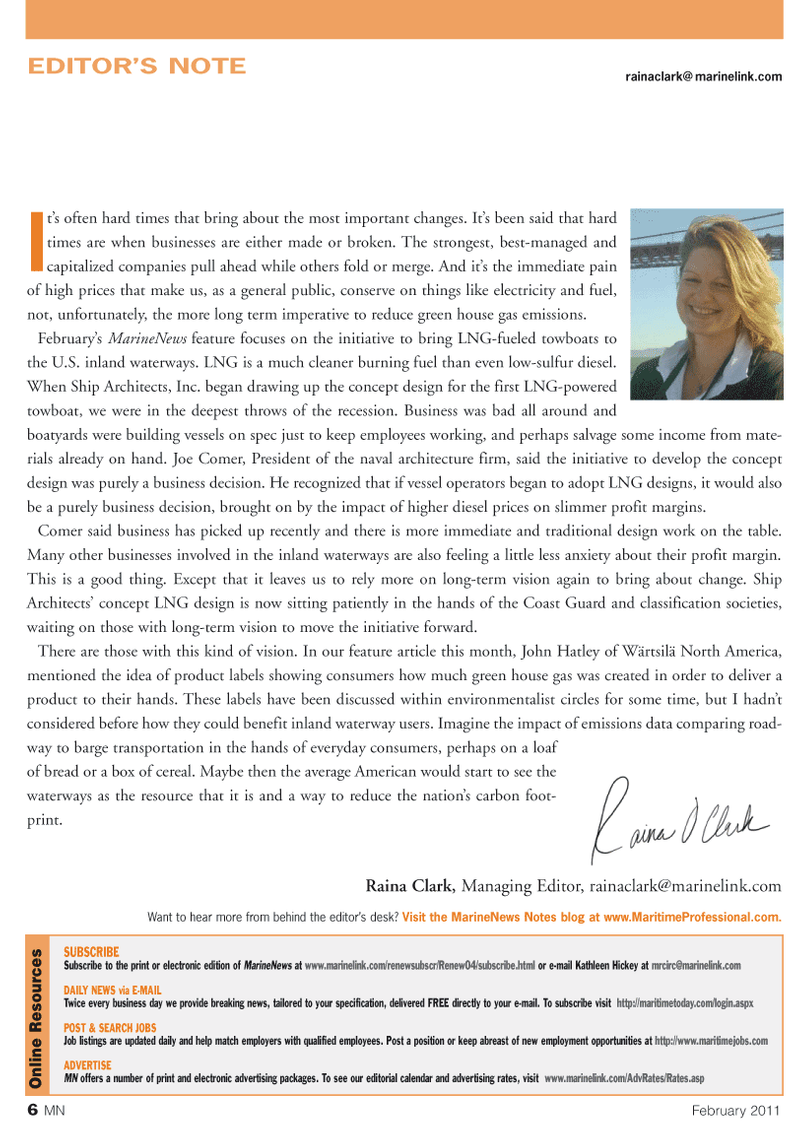
Page 6: of Marine News Magazine (February 2011)
Inland Waterways
Read this page in Pdf, Flash or Html5 edition of February 2011 Marine News Magazine
I t’s often hard times that bring about the most important changes. It’s been said that hard times are when businesses are either made or broken. The strongest, best-managed and capitalized companies pull ahead while others fold or merge. And it’s the immediate pain of high prices that make us, as a general public, conserve on things like electricity and fuel, not, unfortunately, the more long term imperative to reduce green house gas emissions.
February’s MarineNews feature focuses on the initiative to bring LNG-fueled towboats to the U.S. inland waterways. LNG is a much cleaner burning fuel than even low-sulfur diesel.
When Ship Architects, Inc. began drawing up the concept design for the first LNG-powered towboat, we were in the deepest throws of the recession. Business was bad all around and boatyards were building vessels on spec just to keep employees working, and perhaps salvage some income from mate- rials already on hand. Joe Comer, President of the naval architecture firm, said the initiative to develop the concept design was purely a business decision. He recognized that if vessel operators began to adopt LNG designs, it would also be a purely business decision, brought on by the impact of higher diesel prices on slimmer profit margins.
Comer said business has picked up recently and there is more immediate and traditional design work on the table.
Many other businesses involved in the inland waterways are also feeling a little less anxiety about their profit margin.
This is a good thing. Except that it leaves us to rely more on long-term vision again to bring about change. Ship
Architects’ concept LNG design is now sitting patiently in the hands of the Coast Guard and classification societies, waiting on those with long-term vision to move the initiative forward.
There are those with this kind of vision. In our feature article this month, John Hatley of Wärtsilä North America, mentioned the idea of product labels showing consumers how much green house gas was created in order to deliver a product to their hands. These labels have been discussed within environmentalist circles for some time, but I hadn’t considered before how they could benefit inland waterway users. Imagine the impact of emissions data comparing road- way to barge transportation in the hands of everyday consumers, perhaps on a loaf of bread or a box of cereal. Maybe then the average American would start to see the waterways as the resource that it is and a way to reduce the nation’s carbon foot- print.
SUBSCRIBE
Subscribe to the print or electronic edition of MarineNews at www.marinelink.com/renewsubscr/Renew04/subscribe.html or e-mail Kathleen Hickey at [email protected]
DAILY NEWS via E-MAIL
Twice every business day we provide breaking news, tailored to your specification, delivered FREE directly to your e-mail. To subscribe visit http://maritimetoday.com/login.aspx
POST & SEARCH JOBS
Job listings are updated daily and help match employers with qualified employees. Post a position or keep abreast of new employment opportunities at http://www.maritimejobs.com
ADVERTISE
MN offers a number of print and electronic advertising packages. To see our editorial calendar and advertising rates, visit www.marinelink.com/AdvRates/Rates.asp
Raina Clark, Managing Editor, [email protected]
Want to hear more from behind the editor’s desk? Visit the MarineNews Notes blog at www.MaritimeProfessional.com.
Online Resour ces 6 MN February 2011
EDITOR’S NOTE rainaclark@ marinelink.com

 5
5

 7
7
